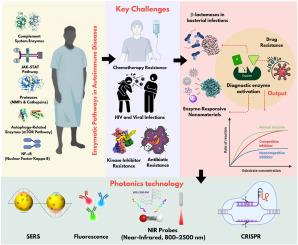Smart nanophotonics for enzyme-driven drug resistance sensing and controlled therapeutic release
IF 4.9
3区 医学
Q1 PHARMACOLOGY & PHARMACY
Journal of Drug Delivery Science and Technology
Pub Date : 2025-09-05
DOI:10.1016/j.jddst.2025.107488
引用次数: 0
Abstract
Drug resistance is a major worldwide health issue, with a growing incidence leading to increased morbidity and mortality. Molecular diagnostics require solutions that combine sensitivity, flexibility, and responsiveness. This review summarizes current understanding of the involvement of enzymes in the many processes that drive drug resistance and discusses the possible uses of enzyme-responsive nanomaterials. It investigates modern strategies used in the literature to monitor and mitigate drug resistance processes, such as Surface-Enhanced Raman Scattering (SERS), fluorescence imaging, CRISPR-based diagnostics, and near-infrared (NIR) detection. Published research shows that combining enzyme-responsive nanomaterials with photonic technology is a potential technique for detection of drug resistance and molecular sensing. These nanoplatforms allow for the quick and selective detection of disease biomarkers, such as enzymes associated with diseased states and resistant phenotypes, using enzyme-triggered activation mechanisms and photonic signal transduction. As a result, localized therapeutic release is demonstrated to enhance therapy specificity and reduce systemic toxicity. Moreover, insights into the molecular processes that underpin drug resistance improve our understanding of drug modification and metabolism. Advances in nanotechnology, artificial intelligence, and machine learning are increasing our ability to analyze enzyme behavior and inform treatment plans. By incorporating diagnostic and therapeutic capabilities into adaptable nanoplatforms, the reviewed approaches represent a significant step forward in smart nanomedicine. Consequently, it provides new possibilities for the treatment of drug-resistant cancers and infectious diseases in an environmentally friendly approach.

智能纳米光子学用于酶驱动的耐药传感和控制治疗释放
耐药性是世界范围内的一个主要健康问题,其发病率不断上升,导致发病率和死亡率上升。分子诊断需要结合灵敏度、灵活性和响应性的解决方案。这篇综述总结了目前对酶在驱动耐药的许多过程中的参与的理解,并讨论了酶反应纳米材料的可能用途。它研究了文献中用于监测和减轻耐药过程的现代策略,如表面增强拉曼散射(SERS)、荧光成像、基于crispr的诊断和近红外(NIR)检测。已发表的研究表明,将酶反应纳米材料与光子技术相结合是一种潜在的耐药性检测和分子传感技术。这些纳米平台允许使用酶触发的激活机制和光子信号转导快速和选择性地检测疾病生物标志物,例如与疾病状态和抗性表型相关的酶。因此,局部治疗释放被证明可以增强治疗特异性并降低全身毒性。此外,对支持耐药性的分子过程的深入了解提高了我们对药物修饰和代谢的理解。纳米技术、人工智能和机器学习的进步提高了我们分析酶行为和制定治疗计划的能力。通过将诊断和治疗能力纳入适应性纳米平台,所审查的方法代表了智能纳米医学的重要一步。因此,它为以环境友好的方式治疗耐药癌症和传染病提供了新的可能性。
本文章由计算机程序翻译,如有差异,请以英文原文为准。
求助全文
约1分钟内获得全文
求助全文
来源期刊
CiteScore
8.00
自引率
8.00%
发文量
879
审稿时长
94 days
期刊介绍:
The Journal of Drug Delivery Science and Technology is an international journal devoted to drug delivery and pharmaceutical technology. The journal covers all innovative aspects of all pharmaceutical dosage forms and the most advanced research on controlled release, bioavailability and drug absorption, nanomedicines, gene delivery, tissue engineering, etc. Hot topics, related to manufacturing processes and quality control, are also welcomed.

 求助内容:
求助内容: 应助结果提醒方式:
应助结果提醒方式:


